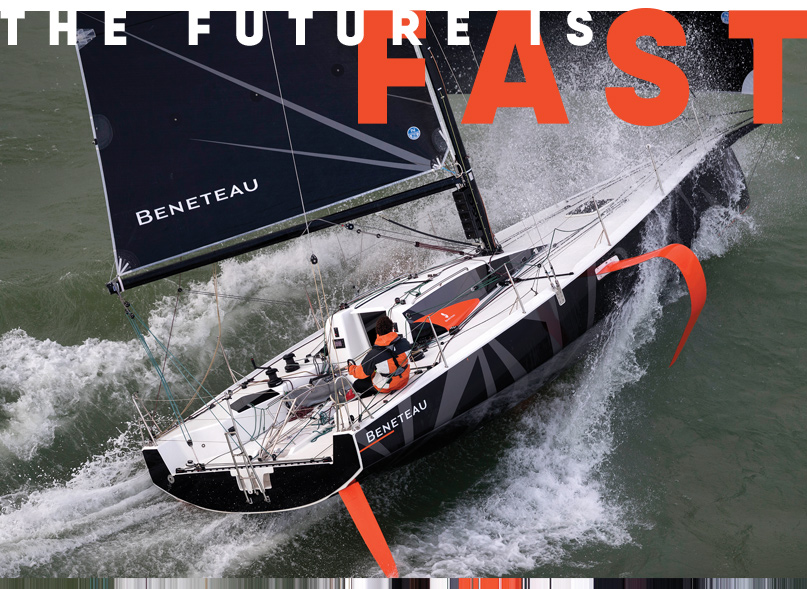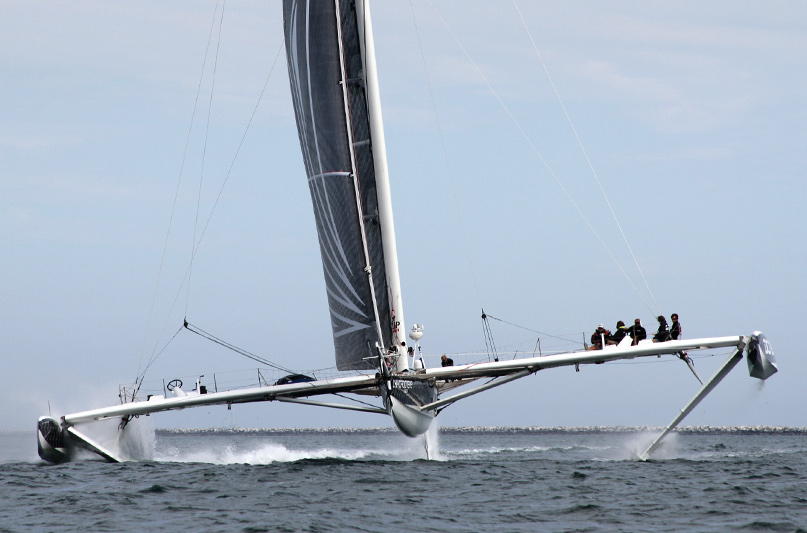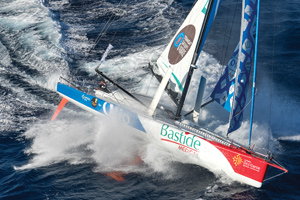
 In the 2013 America’s Cup, the sailing world was transfixed on the 72-foot catamarans racing under the Golden Gate Bridge. Not only was it a major turning point away from the traditional monohull racing of America’s Cups gone by, but this time competitors brought something most people had never seen: flying boats. It was no longer a game of hundredths of a knot making the difference in the race, it was a white-knuckle game of chicken with yachts approaching one another at freeway speeds and computers strapped to wrists taking the place of the wise, moustache-sporting tactician.
In the 2013 America’s Cup, the sailing world was transfixed on the 72-foot catamarans racing under the Golden Gate Bridge. Not only was it a major turning point away from the traditional monohull racing of America’s Cups gone by, but this time competitors brought something most people had never seen: flying boats. It was no longer a game of hundredths of a knot making the difference in the race, it was a white-knuckle game of chicken with yachts approaching one another at freeway speeds and computers strapped to wrists taking the place of the wise, moustache-sporting tactician.
The racing would go into the record books as the largest comeback in America’s Cup history. James Spithill and the stacked team of the Oracle Racing came back from eight points behind to win out against Dean Barker and the Kiwis from Emirates Team New Zealand. It was not until the American team prioritized getting the boat to ride on the foils that they could come back for the win. Not only did this cycle of The Cup show the world at large how far sailing had come since the days of polo shirts and Jennifer Grey’s “Whomper” (from the movie Wind), it showed a glimpse of the future, and the future is fast.
At its core, the term foiling refers to utilizing a hydrodynamic lifting wing that rides in the water below a boat to push the boat upward. When a foil-equipped boat reaches a certain speed, the boat rises out of the water onto the J- or T-shaped foils. This dramatically reduces the water displaced by the boat and the drag associated with moving all that water out of the way. These forces work the same way as an airplane wing, with the water splitting around the blade shape, generating a pulling effect that lifts the boat upward.

Above: Comin’ at ya real hot! Hydroptère, designed by French yachtsman Alain Thébault, passed 50 knots in 2009, wowing the sailing world, only to end up abandoned in Hawaii in 2016 (Photo: Thomas Lesage).
The trick to using foils effectively relies on a multitude of factors, but most significant is the boat’s weight, more specifically being less than the lifting force that the foils can generate, thus enabling the boat to rise. The secret sauce is a closely guarded, highly refined cocktail with the appropriate mixings of lift vs. speed, control vs. drag, and all the while allowing the crew to control both the flight behavior and steering while foiling and in light wind before the boat lifts off.
This has become possible in recent years thanks to advancements in both computational and materials science. Everything from high-strength carbon fiber and low-weight honeycomb structures to optimize performance to advanced computer fluid dynamic simulations that calculate precise shapes are combined into these amazing machines. The line between aerospace and boat building is essentially non-existent, with top builders playing at the forefront of technology and even pioneering techniques to make boats stronger and lighter.
While gaining popularity and practicality in recent years, in reality, foiling had been around for decades before racing in the San Francisco Bay brought it to the world stage. The Hydrosail Inc. Team broke the 30-knot barrier all the way back in 1979. The effort was capped off with a commercial version of the foiling catamaran used during the record attempt, but the idea never caught on beyond a handful of diehard sailors. Fast forward to 2008 and foiling technology, while moving forward, remained more in the realm of experimental rather than reality.
The French Hydroptère was setting YouTube ablaze with their spectacular speed and a successful run at the illusive 50-knot barrier, taking the one-mile record with a 50.17 knots average speed. The team set out on a mission to prove that foiling was not just for one-mile speed runs and set off for a record attempt from Los Angeles to Hawaii, completing the 2,215 nautical mile trip without major issues, though not breaking the record.
Almost in tribute to the extreme nature of this experimental boat, upon completing the trip, it was left tied to the dock in Oahu to rot, eventually being auctioned off by the harbor master as an abandoned vessel some months later.
While many extreme hydro-foiling concepts have come and gone, some in more spectacular ways than others, this anecdote is a standout.
Beyond an exotic, experimental one-off breaking the barriers, there are several groundbreaking groups developing foiling for the masses, all be it the highly trained, hyper-athletic masses. Advanced development dinghy classes are always leading the way in the latest technology, and being far less expensive relative to large yachts, it is a natural fit to see groundbreaking and sometimes bone-breaking developments.
The first boat that comes to mind when thinking about a hydrofoil dinghy is certainly the Foiling Moth. Utilizing its now iconic T foil centerboard and wide hiking benches, the Moth is perhaps the most common sailing hydrofoil in the world. In a development class tracing its roots back to the 1920s, the Moth incorporated lifting foils that utilized a mechanical control system in the early 2000s; and its popularity exploded as the new technology brought foiling to the fleet racing world.
The class’ success continues with the world championship fleet including America’s Cup skippers and Olympic hopefuls as well as champions, all helped by more sailing hardware than you could fit in a Hanse. Over 200 sailors competed in the 2017 world championships, a significant portion of which were junior racers, proving a point that the fleet hit on something—giving people a competitive structure to experience the absolute pinnacle of sailing technology.

Right: The Nacra 17 one-design catamaran will bring fully foiling fleet racing onto the world stage in the Paris 2020 Olympics.
Looking to pick up where the Moth left off, in perhaps the most progressive decision by World Sailing in recent memory, the Nacra17 is now slotted to be the first foiling sailboat to be raced in the 2020 Olympics. Transitioning from a semi-foiling catamaran to a fully foiling double trapeze class is sure to attract the best of modern high-performance sailors with many of the world’s top racers already signing up for preliminary events. This decision follows the world championships in 2017, which were sailed for the first time in fully foiling boats.
This is a welcomed change from two Olympics ago when it was questionable if the multihull was going to be a part of sailing going forward. This decision by the Olympic committee and World Sailing puts up a rather large flag that solidifies foiling as more than a passing trend.
Coming back down to earth, there are those who want to bring hydrofoils to the club-level racer and family sailing dinghy. Envisioned by a group of junior sailors and executed by a skilled and experienced build team, the Unidentified Foiling Object by Fulcrum Speed Works is a true grassroots effort to design and produce an affordable and simple foiling dinghy that anyone with basic sailing experience can learn to sail. Priced at $7,600 for the single sail, one-person dinghy, this model is competitive with even an entry level dinghy and opens the crew weight up to anywhere between 90 to 230 pounds, making this a foiling option for everyone. This truly cost-effective foiling design appeals to the hardcore racer as well as the weekend warrior and is available as a turnkey option.

Looking beyond dinghies and day sailors, foiling is also making breakaway strides in the big boat, ocean-racing world. Everything from 70’ multihulls knocking days off race records to a Mini 6.5 blasting across the Atlantic are applying this new technology to improve performance.
One of the most groundbreaking fleets to undergo the foiling transformation is surely the racing series known in the offshore racing circles simply as “The Figaro.” The racing series, a proving ground for some of the world’s top solo ocean racers, has recently updated its tried and true boat to a radical new design, the Figaro Beneteau 3. Utilizing listing foils that protrude from the sides of the hull and apply lift to the leeward side, the foil works to prevent the boat from heeling and allows for more powerful sails to be used without the need for crew weight on the rail, crucial for solo offshore racing.
An added benefit of this class is that a normal person can buy one of these exotic boats direct from Beneteau, though what it would rate in the Northwest is anyone’s guess. This move to foil-assisted boats in the world’s most prestigious sailor development class is a clear line in the sand that the way forward is on wings.
We scoot past a submerged rock and round the tip of Eliza Island as the sun peeks through the clouds, producing a bright orange brushstroke across the horizon. Kruger is across the cockpit from me with a smile stretched ear to ear. “This is what I want to do for the rest of my life,” he says, reflecting on our ski-to-sail day and thinking about his waterborne future. I can’t blame him. We’re cruising along with 15-25 mph winds; we’re surrounded by islands, the sun warms my face, and I think I know how he feels.
Perhaps no fleet has seen this transformation quite like the IMOCA 60s of the Vendee Globe Race. Armel Le Cléac’h’s Banque Populaire VIII and Alex Thompson’s Hugo Boss traded blows around the world in the most epic racing in recent memory. Both boats were sporting Salvador Dali moustache-style foils that helped lift the boats free from the water, making for ridiculous speeds and spectacular open ocean sailing, the likes of which has never been seen before. At the end of the 2016-2017 race, after sailing 79 days nonstop, single handed, at times sailing over in gale conditions averaging over 30 knots of boat speed, the two lead boats were separated by a mere 16 hours, with Armel Le Cléac’h taking the win.
The success of the class is soon to be expanded with the former Volvo Ocean Race now transitioning to the boats that will be raced fully crewed, pushing the limits even further beyond what was thought possible only a few years ago. With most of the top performing teams currently building new boats optimized around lifting foils, it is absolutely the class to watch over the next few years.
To answer the nagging question if hydro foiling sailing and racing boats are the future, in short, no, they are the present. This exciting technology is certain to make its mark on the history of the sport and has only just begun to come into its own. By combining cutting edge technology with the competitive drive of today’s top racers both at the professional and club level, it’s no wonder that flying boats are constantly expanding their popularity and prevalence across nearly every aspect of the sport. Thanks to the foresight of several racing organizations and the widespread support of sailors, getting up and out of the water is becoming a substantially more attainable dream for everyone.
